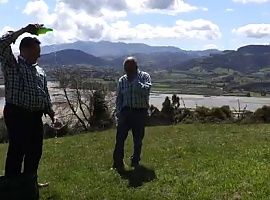PASADENA, California - El Telescopio Espacial Spitzer ha detectado signos de cuerpos helados que llueven en un sistema solar distinto al nuestro. La lluvia se asemeja a la que ocurrió en nuestro propio sistema solar hace varios miles de millones de años, durante un período conocido como el "Bombardeo Pesado Tardío", que pudo haber traído el agua y otros ingredientes que forman la vida en la Tierra.
Durante esta época, los cometas y otros objetos de heladas que fueron arrojados desde el exterior del sistema solar golpearon los planetas interiores. La andanada dejó marcada nuestra luna y produjo grandes cantidades de polvo estelar.
Ahora, el telescopio Spitzer ha detectado una nube de polvo alrededor de una estrella cercana, brillante en el cielo del norte, llamada Eta Corvi, nube que coincide con el contenido de un cometa gigante destruido. Este polvo se encuentra lo suficientemente cerca de Eta Corvi, en cuyo sistema pueden existir mundos como la Tierra pueden existir, lo que sugiere una colisión ocurrida entre un planeta y uno o más cometas. El sistema de Eta Corvi datta de aproximadamente mil millones de años, que los investigadores creen que es la edad adecuada para una tormenta de granizo.
"Creemos que tenemos una evidencia directa de un curso Bombardeo Pesado Tardío en el cercano sistema estelar Eta Corvi, que ocurren casi al mismo tiempo que en nuestro sistema solar", dijo Carey Lisse, científico investigador senior de la Johns Hopkins University Applied Physics Laboratory en Laurel , Maryland, y autor principal de un artículo que detalla los hallazgos. Los resultados serán publicados en el Astrophysical Journal. Lisse presentó los resultados en las señales de los planetas reunión en el Centro Goddard de Vuelo Espacial en Greenbelt, Maryland,este miércoles.
FOTO: NASA/JPL-Caltech
PASADENA, Calif. -- NASA's Spitzer Space Telescope has detected signs of icy bodies raining down in an alien solar system. The downpour resembles our own solar system several billion years ago during a period known as the "Late Heavy Bombardment," which may have brought water and other life-forming ingredients to Earth.
During this epoch, comets and other frosty objects that were flung from the outer solar system pummeled the inner planets. The barrage scarred our moon and produced large amounts of dust.
Now Spitzer has spotted a band of dust around a nearby bright star in the northern sky called Eta Corvi that strongly matches the contents of an obliterated giant comet. This dust is located close enough to Eta Corvi that Earth-like worlds could exist, suggesting a collision took place between a planet and one or more comets. The Eta Corvi system is approximately one billion years old, which researchers think is about the right age for such a hailstorm.
"We believe we have direct evidence for an ongoing Late Heavy Bombardment in the nearby star system Eta Corvi, occurring about the same time as in our solar system," said Carey Lisse, senior research scientist at the Johns Hopkins University Applied Physics Laboratory in Laurel, Md., and lead author of a paper detailing the findings. The findings will be published in the Astrophysical Journal. Lisse presented the results at the Signposts of Planets meeting at NASA's Goddard Space Flight Center in Greenbelt, Md., today, Oct. 19.
Astronomers used Spitzer's infrared detectors to analyze the light coming from the dust around Eta Corvi. Certain chemical fingerprints were observed, including water ice, organics and rock, which indicate a giant comet source.
The light signature emitted by the dust around Eta Corvi also resembles the Almahata Sitta meteorite, which fell to Earth in fragments across Sudan in 2008. The similarities between the meteorite and the object obliterated in Eta Corvi imply a common birthplace in their respective solar systems.
A second, more massive ring of colder dust located at the far edge of the Eta Corvi system seems like the proper environment for a reservoir of cometary bodies. This bright ring, discovered in 2005, looms at about 150 times the distance from Eta Corvi as the Earth is from the sun. Our solar system has a similar region, known as the Kuiper Belt, where icy and rocky leftovers from planet formation linger. The new Spitzer data suggest that the Almahata Sitta meteorite may have originated in our own Kuiper Belt.
The Kuiper Belt was home to a vastly greater number of these frozen bodies, collectively dubbed Kuiper Belt objects. About 4 billion years ago, some 600 million years after our solar system formed, scientists think the Kuiper Belt was disturbed by a migration of the gas-giant planets Jupiter and Saturn. This jarring shift in the solar system's gravitational balance scattered the icy bodies in the Kuiper Belt, flinging the vast majority into interstellar space and producing cold dust in the belt. Some Kuiper Belt objects, however, were set on paths that crossed the orbits of the inner planets.
The resulting bombardment of comets lasted until 3.8 billion years ago. After comets impacted the side of the moon that faces Earth, magma seeped out of the lunar crust, eventually cooling into dark "seas," or maria. When viewed against the lighter surrounding areas of the lunar surface, those seas form the distinctive "Man in the Moon" visage. Comets also struck Earth or incinerated in the atmosphere, and are thought to have deposited water and carbon on our planet. This period of impacts might have helped life form by delivering its crucial ingredients.
"We think the Eta Corvi system should be studied in detail to learn more about the rain of impacting comets and other objects that may have started life on our own planet," Lisse said.




















